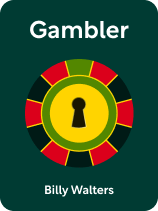

This article is an excerpt from the Shortform book guide to "Gambler" by Billy Walters. Shortform has the world's best summaries and analyses of books you should be reading.
Like this article? Sign up for a free trial here.
What makes Billy Walters one of the most successful sports bettors in history? How did he turn sports betting into a sophisticated, profitable enterprise?
Billy Walters’s sports betting system combines advanced computer modeling with precise bankroll management. His three-part approach transformed gambling from mere chance into a calculated investment strategy.
Read on to discover how Walters built his legendary betting empire.
Billy Walters’s Sports Betting System
Billy Walters’s sports betting system developed out of his experience with the Computer Group and his own company, Sierra Sports Consulting. He explains how these entities operated and details the three components of his approach: handicapping, unit sizing, and betting strategy.
The Computer Group
Billy Walters credits his Las Vegas experience as being crucial to developing his sports betting strategy. He became an integral part of the Computer Group, an organization that utilized advanced computer algorithms to gain an edge over bookmakers’ betting lines.
His involvement with the Computer Group proved highly profitable, allowing him to clear his debts and build significant wealth. By the time the mid-1980s rolled around, Walters had amassed $3.5 million.
The Computer Group’s strategy, as Walters describes it, centered on identifying and capitalizing on betting lines that they believed were incorrectly set.
To illustrate this, consider a football game between the Chiefs and Ravens. If bookmakers set a three-point spread favoring the Chiefs, they’re essentially saying the Chiefs have a 50% chance of winning by three or more points. Any victory margin less than three points would result in a lost bet on the Chiefs.
If the Computer Group’s calculations suggested the spread should actually be six points in the Chiefs’ favor, they would place their bets accordingly. Since their model predicted the Chiefs would perform significantly better than the bookmakers’ estimation, the Computer Group believed they had favorable odds of winning such bets.
Sierra Sports Consulting
Because of a growing desire to bet at levels that the Computer Group couldn’t support—along with some legal trouble—Walters founded his own company, Sierra Sports Consulting, in 1992. According to Walters, Sierra Sports Consulting functioned like an elite investment bank, with “war rooms” running 14 hours a day, seven days a week.
(Shortform note: Outside of Gambler, there aren’t many details to be found about Sierra Sports Consulting or its day-to-day operations. Walters is notorious for keeping quiet about his work—he only gives vague information to interviewers, when he gives any information at all. Furthermore, on at least one occasion, Walters has openly said that he doesn’t trust the media. When Sierra Group encountered legal trouble, he became even more tight-lipped, saying his lawyers had forbidden him from discussing anything related to the investigation into Sierra Group.)
Walters had learned that scale was crucial to sports betting success: For instance, if he had a 5% edge (a higher chance of winning than the calculated odds), then betting $1 million would net him $50,000 in expected profit, while betting $10k would net him only $500. Consequently, he aimed to grow his sports betting operation by finding as many bookmakers as possible who’d take his bets, allowing him to wager exponentially more money than he could while betting only one line at a time.
The upshot is that Walters hired teams of beards—people who placed the bets for him via proxy—who shuttled money around Las Vegas every day. These beards placed bets decided by Walters and other handicappers: those who use computer models to decide which Las Vegas lines are inaccurate and worth exploiting. Walters writes that, during this time frame, his teams were betting several million dollars on a weekly basis.
(Shortform note: In addition to placing more bets than would normally be possible (or permitted), savvy gamblers hire beards for a number of reasons. For example, if a highly successful gambler like Walters were to place a bet in person, the bookmaker might recognize him and change the odds to be less favorable; after all, such a bet would imply that the current line is inaccurate and exploitable. The anonymity of a beard also allows bettors to get around rules preventing them from betting, such as laws forbidding coaches from betting on the sport they coach. It further enables them to place bets with a bookie who’s refused to do business with them.)
The 3 Components of Walters’s Sports Betting System
Between his time with the Computer Group and Sierra Sports Consulting, Walters developed a concrete approach to sports betting success. His approach has three components: handicapping, unit sizing, and betting strategy.
Component #1: Handicapping
Handicapping involves using computer modeling to predict the spread between any two teams (though Walters focuses on American football). Walters created a system in which teams have relative “power rankings” that estimate which team will have the advantage in any given game, and how large that advantage will be. For example, if the Cowboys are worth 45 points and the Cardinals are worth 38 points, the predicted spread would be seven points in the Cowboys’ favor.
Although Walters doesn’t provide an in-depth strategy for creating these power rankings, he does provide a few examples of how he ranked teams. For instance, he writes that home-field advantage is typically worth three points. Additionally, injuries to key players might be worth, one negative point each. So, for instance, if the Cowboys’ running back were injured, that team might have a power ranking of 44 points instead of 45 for their upcoming game.
| Some Factors Handicappers Consider Walters doesn’t go into detail about which factors handicappers consider when creating their rankings, but a few key factors they commonly use include: Overall team strength: The most obvious clue for how two teams will perform in an upcoming game is their respective records for the season—logically, a team that has won the majority of their games would most likely beat a team that has lost most of their games this season. Matchup advantages and disadvantages: How each team tends to perform against teams that are similar to their opponents. For instance, a team that struggles to break through a strong defensive line could be at a disadvantage against an opponent that specializes in defense, regardless of the two teams’ records in the current season. Recent play: Each team’s current form and trends, including how they’ve performed recently (as opposed to their total win record for the season) and how they’ve adapted to any recent changes, such as player injuries or shifts in strategy. Home advantage: While playing at home is often beneficial, handicappers are careful not to overvalue this factor, recognizing that its impact varies between teams and situations. These factors help handicappers set more accurate odds by providing a nuanced understanding of the teams and the likely outcome of the game. |
Component #2: Unit Sizing
After determining his handicapping, Walters would then determine his unit size, meaning the size of his bet as a percentage of his bankroll (or the total amount of money he’s earmarked for gambling)—1% of the bankroll is one “unit.” According to Walters, you should size your bets in proportion to the size of your edge, though never betting more than three units (meaning 3% of your bankroll) at once.
For example, suppose the Giants played the 49ers and Walters’s handicap was 14 points in the Giants’ favor. In this case, the massive discrepancy would justify his maximum bet of three units. By contrast, if Walters’s system calculated only one or two points in the Giants’ favor, he would place a much smaller wager on the Giants to win: say, 0.5% of his bankroll (half a unit).
(Shortform note: Unit sizing provides useful guidelines for how to handle your bankroll, but how should you determine how big that bankroll is in the first place? In Antifragile, risk analyst Nassim Nicholas Taleb suggests using the Barbell Model to plan your investments. This model means keeping most of your money (say, 90%) in a savings account or something similarly safe, and using the remainder for high-risk, high-reward investments—in this case, your gambling bankroll. In this analogy, the “bar” is the spectrum of risk, and the “weights” are your money; you load up both extremes (very low risk and very high risk) while avoiding the middle, just like you don’t put weights in the middle of a barbell.)
Component #3: Betting Strategy
The final component of Walters’s approach involves searching widely for the best lines available to maximize your edge—in other words, look for the bookies whose lines have the greatest discrepancies with the odds you’ve calculated. This will ensure that you get the highest possible return on a winning bet.
For example, you might find that in a game between the Ravens and the Steelers, 10 bookmakers have the spread set at seven points in favor of the Steelers, while one other has it set at only five points in favor of the Steelers. If your handicapping method predicted a spread of, say, eight points in the Steelers’ favor, it’d make sense to place a bet with the bookmaker whose spread is only five points. In short, the more you go against the odds, the more money you’ll get if you win.
(Shortform note: Advancing technology has changed the sports betting landscape since Walters was in his prime by driving a huge increase in in-play betting. With more powerful computers able to calculate odds in real time, and the internet making it possible to transmit data worldwide almost instantly, it’s become much easier to set odds and make bets on the outcomes of quarters or even individual plays. Because of this, some experts say that the sharpest gamblers—those who are able to outpace the bookmakers in calculating odds throughout a game—have even more opportunities to find and exploit the kinds of discrepancies that Walters describes here.)

———End of Preview———
Like what you just read? Read the rest of the world's best book summary and analysis of Billy Walters's "Gambler" at Shortform.
Here's what you'll find in our full Gambler summary:
- How a man born into poverty made over $100 million
- The three components of Billy Walters’s winning approach to sports betting
- Why Billy Walters went to prison and what he learned there






